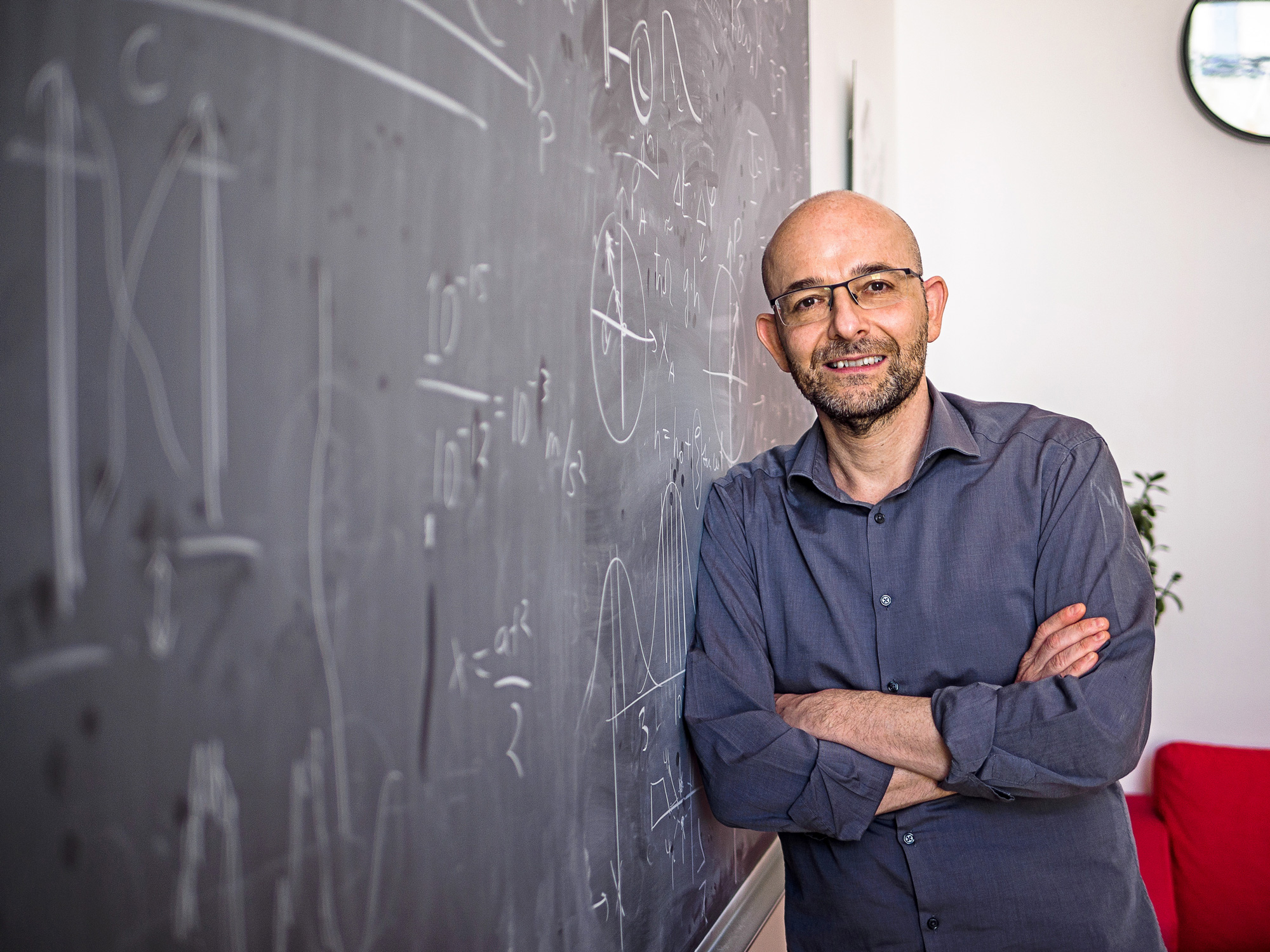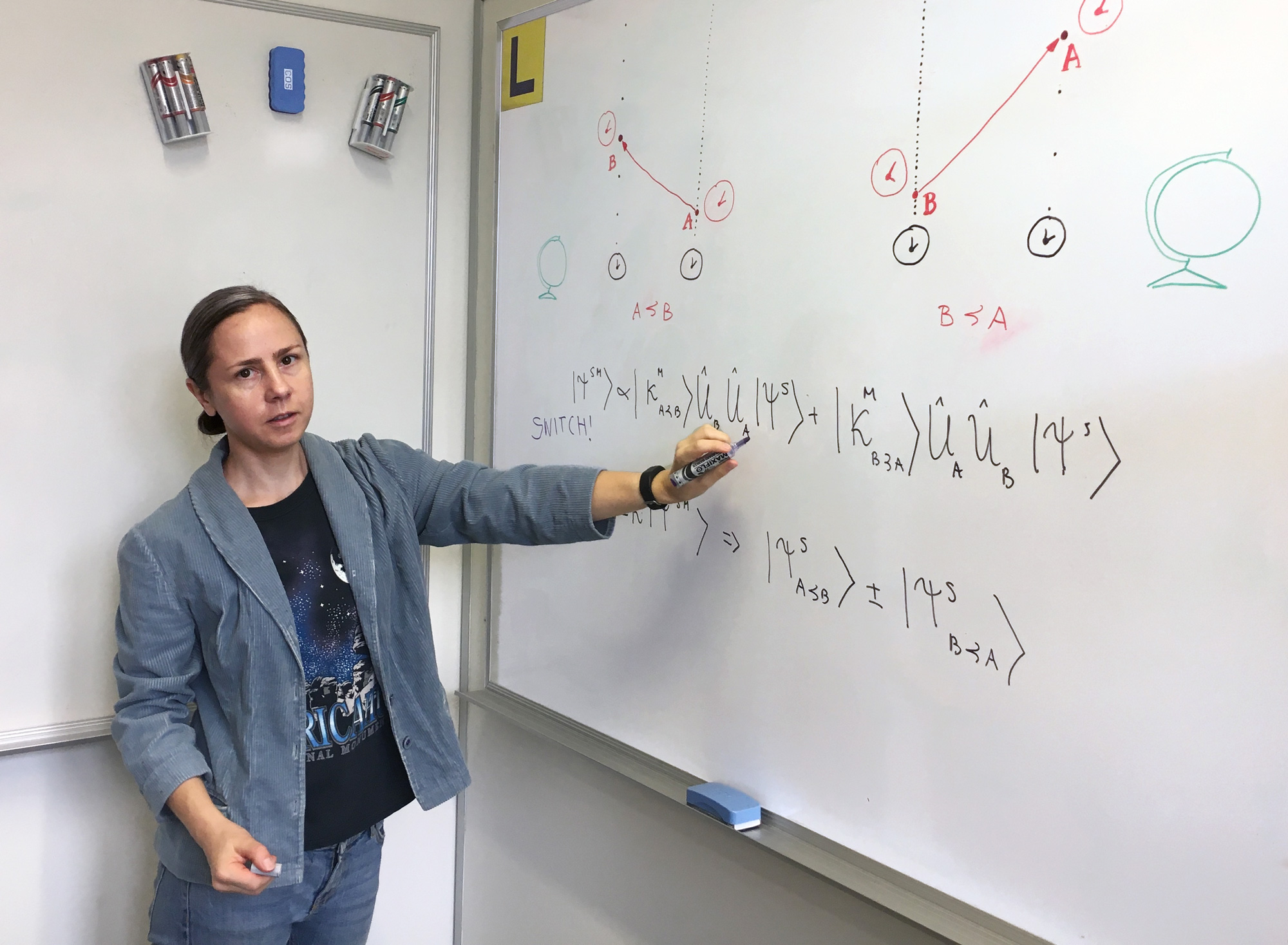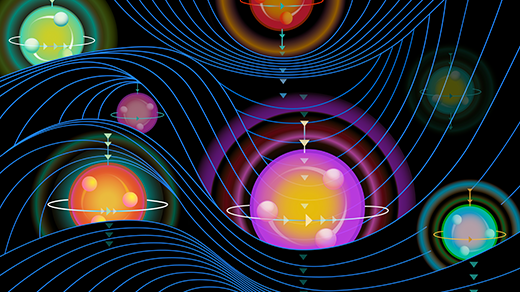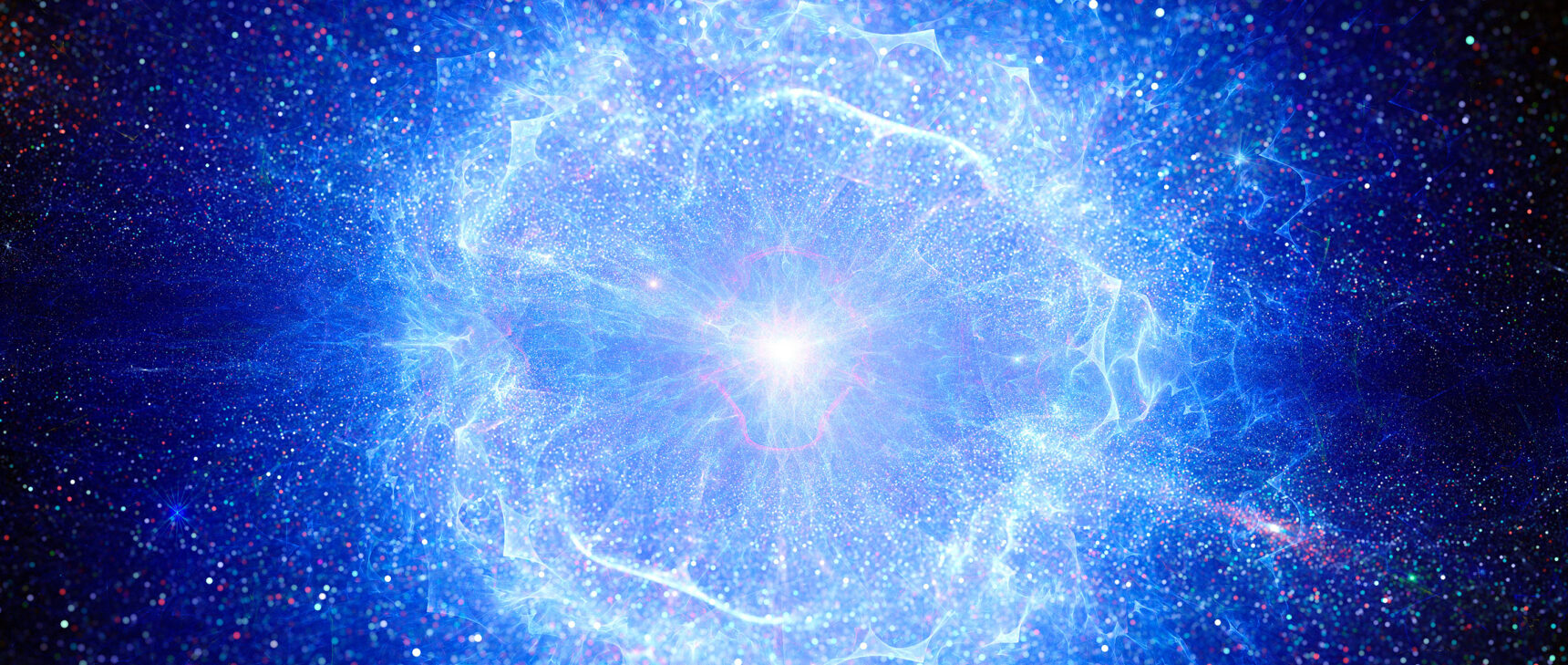Quantum Mischief Rewrites the Laws of Cause and Effect

The mystery of indefinite causal order leaves the order of events uncertain.
Cody Muir for Quanta Magazine
Introduction
Alice and Bob, the stars of so many thought experiments, are cooking dinner when mishaps ensue. Alice accidentally drops a plate; the sound startles Bob, who burns himself on the stove and cries out. In another version of events, Bob burns himself and cries out, causing Alice to drop a plate.
Over the last decade, quantum physicists have been exploring the implications of a strange realization: In principle, both versions of the story can happen at once. That is, events can occur in an indefinite causal order, where both “A causes B” and “B causes A” are simultaneously true.
“It sounds outrageous,” admitted Časlav Brukner, a physicist at the University of Vienna.
The possibility follows from the quantum phenomenon known as superposition, where particles maintain all possible realities simultaneously until the moment they’re measured. In labs in Austria, China, Australia and elsewhere, physicists observe indefinite causal order by putting a particle of light (called a photon) in a superposition of two states. They then subject one branch of the superposition to process A followed by process B, and subject the other branch to B followed by A. In this procedure, known as the quantum switch, A’s outcome influences what happens in B, and vice versa; the photon experiences both causal orders simultaneously.
Over the last five years, a growing community of quantum physicists has been implementing the quantum switch in tabletop experiments and exploring the advantages that indefinite causal order offers for quantum computing and communication. It’s “really something that could be useful in everyday life,” said Giulia Rubino, a researcher at the University of Bristol who led the first experimental demonstration of the quantum switch in 2017.
But the practical uses of the phenomenon only make the deep implications more acute.
Physicists have long sensed that the usual picture of events unfolding as a sequence of causes and effects doesn’t capture the fundamental nature of things. They say this causal perspective probably has to go if we’re ever to figure out the quantum origin of gravity, space and time. But until recently, there weren’t many ideas about how post-causal physics might work. “Many people think that causality is so basic in our understanding of the world that if we weaken this notion we would not be able to make coherent, meaningful theories,” said Brukner, who is one of the leaders in the study of indefinite causality.
That’s changing as physicists contemplate the new quantum switch experiments, as well as related thought experiments in which Alice and Bob face causal indefiniteness created by the quantum nature of gravity. Accounting for these scenarios has forced researchers to develop new mathematical formalisms and ways of thinking. With the emerging frameworks, “we can make predictions without having well-defined causality,” Brukner said.
Correlation, Not Causation
Progress has grown swifter recently, but many practitioners trace the origin of this line of attack on the quantum gravity problem to work 16 years ago by Lucien Hardy, a British-Canadian theoretical physicist at the Perimeter Institute for Theoretical Physics in Waterloo, Canada. “In my case,” said Brukner, “everything started with Lucien Hardy’s paper.”
Hardy was best known at the time for taking a conceptual approach made famous by Albert Einstein and applying it to quantum mechanics.
Einstein revolutionized physics not by thinking about what exists in the world, but by considering what individuals can possibly measure. In particular, he imagined people on moving trains making measurements with rulers and clocks. By using this “operational” approach, he was able to conclude that space and time must be relative.
In 2001, Hardy applied this same approach to quantum mechanics. He reconstructed all of quantum theory starting from five operational axioms.
He then set out to apply it to an even bigger problem: the 80-year-old problem of how to reconcile quantum mechanics and general relativity, Einstein’s epic theory of gravity. “I’m driven by this idea that perhaps the operational way of thinking about quantum theory may be applied to quantum gravity,” Hardy told me over Zoom this winter.
The operational question is: In quantum gravity, what can we, in principle, observe? Hardy thought about the fact that quantum mechanics and general relativity each have a radical feature. Quantum mechanics is famously indeterministic; its superpositions allow for simultaneous possibilities. General relativity, meanwhile, suggests that space and time are malleable. In Einstein’s theory, massive objects like Earth stretch the space-time “metric” — essentially the distance between hash marks on a ruler, and the duration between ticks of clocks. The nearer you are to a massive object, for instance, the slower your clock ticks. The metric then determines the “light cone” of a nearby event — the region of space-time that the event can causally influence.
When you combine these two radical features, Hardy said, two simultaneous quantum possibilities will stretch the metric in different ways. The light cones of events become indefinite — and thus, so does causality itself.
Most work on quantum gravity elides one of these features. Some researchers, for instance, attempt to characterize the behavior of “gravitons,” quantum units of gravity. But the researchers have the gravitons interact against a fixed background time. “We’re so used to thinking about the world evolving in time,” Hardy noted. He reasons, though, that quantum gravity will surely inherit general relativity’s radical feature and lack fixed time and fixed causality. “So the idea is really to throw caution to the wind,” said the calm, serious physicist, “and really embrace this wild situation where you have no definite causal structure.”
Over Zoom, Hardy used a special projector to film a whiteboard, where he sketched out various thought experiments, starting with one that helped him see how to describe data entirely without reference to the causal order of events.
He imagined an array of probes drifting in space. They’re taking data — recording, say, the polarized light spewing out of a nearby exploding star, or supernova. Every second, each probe logs its location, the orientation of its polarizer (a device like polarized sunglasses that either lets a photon through or blocks it depending on its polarization), and whether a detector, located behind the polarizer, detects a photon or not. The probe transmits this data to a man in a room, who prints it on a card. After some time, the experimental run ends; the man in the room shuffles all the cards from all the probes and forms a stack.
The probes then rotate their polarizers and make a new series of measurements, producing a new stack of cards, and repeat the process, so that the man in the room ultimately has many shuffled stacks of out-of-order measurements. “His job is to try to make some sense of the cards,” Hardy said. The man wants to devise a theory that accounts for all the statistical correlations in the data (and, in this way, describes the supernova) without any information about the data’s causal relationships or temporal order, since those might not be fundamental aspects of reality.
How might the man do this? He could first arrange the cards by location, dealing out cards from each stack so that those pertaining to spacecraft in a certain region of space go in the same pile. In doing this for each stack, he could start to notice correlations between piles. He might note that whenever a photon is detected in one region, there’s a high detection probability in another region, so long as the polarizers are angled the same way in both places. (Such a correlation would mean that the light passing through these regions tends to share a common polarization.) He could then combine probabilities into expressions pertaining to larger composite regions, and in this way, he could “build up mathematical objects for bigger and bigger regions from smaller regions,” Hardy said.
What we normally think of as causal relationships — such as photons traveling from one region of the sky to another, correlating measurements made in the first region with measurements made later in the second region — act, in Hardy’s formalism, like data compression. There’s a reduction in the amount of information needed to describe the whole system, since one set of probabilities determines another.
Hardy called his new formalism the “causaloid” framework, where the causaloid is the mathematical object used to calculate the probabilities of outcomes of any measurement in any region. He introduced the general framework in a dense 68-page paper in 2005, which showed how to formulate quantum theory in the framework (essentially by reducing its general probability expressions to the specific case of interacting quantum bits).
Hardy thought it should be possible to formulate general relativity in the causaloid framework too, but he couldn’t quite see how to proceed. If he could manage that, then, he wrote in another paper, “the framework might be used to construct a theory of quantum gravity.”
The Quantum Switch
A few years later, in Pavia, Italy, the quantum information theorist Giulio Chiribella and three colleagues were mulling over a different question: What kinds of computations are possible? They had in mind the canonical work of the theoretical computer scientist Alonzo Church. Church developed a set of formal rules for building functions — mathematical machines that take an input and yield an output. A striking feature of Church’s rulebook is that the input of a function can be another function.
The four Italian physicists asked themselves: What kinds of functions of functions might be possible in general, beyond what computers were currently capable of? They came up with a procedure that involves two functions, A and B, that get assembled into a new function. This new function — what they called the quantum switch — is a superposition of two options. In one branch of the superposition, the function’s input passes through A, then B. In the other, it passes through B, then A. They hoped that the quantum switch “could be the basis of a new model of computation, inspired by the one of Church,” Chiribella told me.
At first, the revolution sputtered. Physicists couldn’t decide whether the quantum switch was deep or trivial, or if it was realizable or merely hypothetical. Their paper took four years to get published.
By the time it finally came out in 2013, researchers were starting to see how they might build quantum switches.
They might, for instance, shoot a photon toward an optical device called a beam splitter. According to quantum mechanics, the photon has a 50-50 chance of being transmitted or reflected, and so it does both.
The transmitted version of the photon hurtles toward an optical device that rotates the polarization direction of the light in some well-defined way. The photon next encounters a similar device that rotates it a different way. Let’s call these devices A and B, respectively.
Meanwhile, the reflected version of the photon encounters B first, then A. The end result of the polarization in this case is different.
We can think of these two possibilities — A before B, or B before A — as indefinite causal order. In the first branch, A causally influences B in the sense that if A hadn’t occurred, B’s input and output would be totally different. Likewise, in the second branch, B causally influences A in that the latter process couldn’t have happened otherwise.
After these alternative causal events have occurred, another beam splitter reunites the two versions of the photon. Measuring its polarization (and that of many other photons) yields a statistical spread of outcomes.
Brukner and two collaborators devised ways to quantitatively test whether these photons are really experiencing an indefinite causal order. In 2012, the researchers calculated a ceiling on how statistically correlated the polarization results can be with the rotations performed at A and B if the rotations occurred in a fixed causal order. If the value exceeds this “causal inequality,” then causal influences must go in both directions; causal order must have been indefinite.
“The idea of the causal inequality was really cool, and a lot of people decided to jump in the field,” said Rubino, who jumped in herself in 2015. She and her colleagues produced a landmark demonstration of the quantum switch in 2017 that worked roughly like the one above. Using a simpler test devised by Brukner and company, they confirmed that causal order was indefinite.
Attention turned to what could be done with the indefiniteness. Chiribella and co-authors argued that far more information could be transmitted over noisy channels when sent through the channels in an indefinite order. Experimentalists at the University of Queensland and elsewhere have since demonstrated this communication advantage.
In “the most beautiful experiment” done so far, according to Rubino, Jian-Wei Pan at the University of Science and Technology of China in Hefei demonstrated in 2019 that two parties can compare long strings of bits exponentially more efficiently when transmitting bits in both directions at once rather than in a fixed causal order — an advantage proposed by Brukner and co-authors in 2016. A different group in Hefei reported in January that, whereas engines normally need a hot and cold reservoir to work, with a quantum switch they could extract heat from reservoirs of equal temperature — a surprising use suggested a year ago by Oxford theorists.
It’s not immediately clear how to extend this experimental work to investigate quantum gravity. All the papers about the quantum switch nod at the link between quantum gravity and indefinite causality. But superpositions of massive objects — which stretch the space-time metric in multiple ways at once — collapse so quickly that no one has thought of how to detect the resulting fuzziness of causal relationships. So instead researchers turn to thought experiments.
Quantum Equivalence Principle
You’ll recall Alice and Bob. Imagine they’re stationed in separate laboratory spaceships near Earth. Bizarrely (but not impossibly), Earth is in a quantum superposition of two different places. You don’t need a whole planet to be in superposition for gravity to create causal indefiniteness: Even a single atom, when it’s in a superposition of two places, defines the metric in two ways simultaneously. But when you’re talking about what’s measurable in principle, you might as well go big.
In one branch of the superposition, Earth is nearer to Alice’s lab, and so her clock ticks slower. In the other branch, Earth is nearer to Bob, so his clock ticks slower. When Alice and Bob communicate, causal order gets all switched up.
In a key paper in 2019, Magdalena Zych, Brukner and collaborators proved that this situation would allow Alice and Bob to achieve indefinite causal order.
Samuel Velasco/Quanta Magazine
First, a photon is split by a beam splitter into two possible paths and heads to both Alice’s lab and Bob’s. The setup is such that in the branch of the superposition where Alice’s clock ticks slower, the photon reaches Bob’s lab first; he rotates its polarization and sends the photon to Alice, who then performs her own rotation and sends the photon on to a third person, Charlie, in a faraway third lab. In the other branch of the superposition, the photon reaches Alice first and goes from her to Bob to Charlie. Just as in the example of the quantum switch, this “gravitational quantum switch” creates a superposition of A then B and B then A.
Charlie then brings the photon’s two paths back together and measures its polarization. Alice, Bob and Charlie run the experiment over and over. They find that their rotations and measurement outcomes are so statistically correlated that the rotations must have happened in an indefinite causal order.
To analyze causal indefiniteness in scenarios such as this, the Vienna researchers developed a way of encoding probabilities for observing different outcomes in different locations without reference to a fixed background time, as in Hardy’s causaloid approach. Their “process matrix formalism” can handle probabilities that causally influence each other in neither direction, one direction or both at once. “You can very well define conditions under which you can preserve these probabilities but didn’t assume that probabilities are before or after,” Brukner said.
Meanwhile, Hardy achieved his goal of formulating general relativity in the causaloid framework in 2016. Essentially, he found a fancier way of sorting his stacks of cards. He showed that you can map any measurements that you might make onto an abstract space devoid of causal assumptions. You might, for instance, inspect a small patch of the universe and measure everything you can about it — the density of oxygen, the amount of dark energy, and so on. You can then plot the measurements of this patch as a single point in an abstract high-dimensional space, one that has a different axis for each measurable quantity. Repeat for as many patches of space-time as you please.
After you’ve mapped space-time’s contents in this other space, patterns and surfaces begin to appear. The plot retains all the correlations that existed in space-time, but now without any sense of background time, or cause and effect. You can then use the causaloid framework to build up expressions for probabilities pertaining to larger and larger regions of the plot.
This common framework for both quantum mechanics and general relativity may provide a language for quantum gravity, and Hardy is busy mulling next steps.


Časlav Brukner of the University of Vienna, Magdalena Zych of the University of Queensland and other theorists have developed new mathematical frameworks for analyzing situations in which gravity renders causality indefinite.
IQOQI and Mateusz Kotyrba; Courtesy of Magdalena Zych
There’s one concept that both he and the Vienna theorists have recently identified as a potential bridge to future, post-causal physics: A “quantum equivalence principle” analogous to the equivalence principle that, a century ago, showed Einstein the way to general relativity. One way of stating Einstein’s equivalence principle is that even though space-time can wildly stretch and curve, local patches of it (such as the inside of a falling elevator) look flat and classical, and Newtonian physics applies. “The equivalence principle allowed you to find the old physics inside the new physics,” Hardy said. “That gave Einstein just enough.”
Here’s the analogous principle: Quantum gravity allows the space-time metric to curve wildly in multiple ways simultaneously. This means any event will have multiple mismatched light cones — in short, causality is indefinite.
But Hardy notes that if you look at different space-time metrics, you can find a way of identifying points so that the light cones match up, at least locally. Just as space-time looks Newtonian inside Einstein’s elevator, these points define a reference frame where causality looks definite. “Points that were in the future of one light cone are also in the future of the other ones, so their local causal structure agrees.”
Hardy’s quantum equivalence principle asserts that there will always be such points. “It’s a way to deal with the wildness of indefinite causal structure,” he said.
Einstein came up with his equivalence principle in 1907 and took until 1915 to work out general relativity; Hardy hopes to chart a similar course in his pursuit of quantum gravity, though he notes, “I’m not as smart as Einstein, nor as young.”
Brukner, Flaminia Giacomini and others are pursuing similar ideas about quantum reference frames and equivalence principles.
It’s not yet clear how these researchers’ operational approach to quantum gravity intersects efforts like string theory and loop quantum gravity, which more directly aim to quantize gravity into discrete units (invisibly small “strings” or “loops” in those two cases). Brukner notes that these latter approaches “do not have immediate operational implications.” Like Hardy, he prefers to “try to clarify concepts involved and try to connect them to things that we can, in principle, observe.”
But ultimately quantum gravity must be specific — answering not just the question “What can we observe?” but also “What exists?” That is, what are the quantum building blocks of gravity, space and time?
According to Zych, research on indefinite causal structures is helping with the search for the full theory of quantum gravity in two ways: by providing a mathematical framework, and by informing the development of specific theories, since the reasoning should hold in any approach to the quantization of gravity. She said, “We are building intuition about the phenomena associated with quantum features of temporal and causal order, which will help to get our heads around these issues within a complete quantum gravity theory.”
Hardy is currently participating in a large research collaboration called QISS aimed at cross-fertilizing communities of researchers like him, with backgrounds in quantum foundations and quantum information, with other communities of quantum gravity researchers. Carlo Rovelli, a well-known loop quantum gravity theorist at Aix-Marseille University in France who leads QISS, called Hardy “an accurate thinker” who approaches issues “from a different perspective and with a different language” that Rovelli finds useful.
Hardy thinks his causaloid framework might be compatible with loops or strings, potentially suggesting how to formulate those theories in a way that doesn’t envision objects evolving against a fixed background time. “We’re trying to find different routes up the mountain,” he said. He suspects that the surest route to quantum gravity is the one that “has at its heart this idea of indefinite causal structure.”
This article was reprinted on Wired.com.



